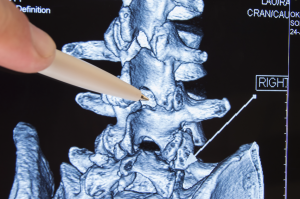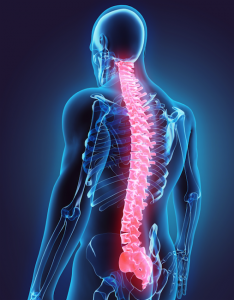Transforaminal Epidural Steroid Injection (TFESI) Series

What is a Transforaminal Epidural Steroid Injection?
A TFESI involves injecting medication into the epidural space, where irritated nerve roots are located. This injection uses a long-lasting steroid and may also include a local anesthetic (usually lidocaine). This local anesthetic allows the surgeon to numb the area so the patient does not feel the deeper injection. The steroid reduces the inflammation/irritation of the nerves, and the anesthetic works to interrupt the pain signal transmission. The medications also spread to other levels and portions of the spine, further reducing inflammation and irritation. While a Transforaminal Epidural Steroid Injection does not cure the condition, it typically offers pain relief and help the physician correctly diagnose where the pain comes from. Do not confuse with Epidural Steroid Injections or a Cervical Epidural Steroid Injection.
How does a Transforaminal Epidural Steroid Injection work?
The body feels sensation and pain from spinal nerves. Spinal nerves branch off from the spinal cord which starts at the brain and travels down the back, and send signals from the body back to the brain. When a physician performs a Transforaminal Epidural Steroid Injection, the injection decreases the inflammation in the effected spinal nerve and in turn reduces the pain. The physician then understands where the pain originates and can treat the injured and inflamed area. Physicians perform TFESIs in the cervical, thoracic, lumbar, or sacral portion of the spine.
AOA Orthopedic Specialists spine specialists use fluoroscopic guidance to position the needles in the epidural space. The use of contrast dye allows the surgeon to confirm correct placement of the injection. This ensures that the medications will be in the  proper area in order to relieve pain. Once the physician confirms the needle’s position, the physician injects the medication.
proper area in order to relieve pain. Once the physician confirms the needle’s position, the physician injects the medication.
Who is a candidate for a Transforaminal Epidural Steroid Injection?
A physician may perform a Transforaminal Epidural Steroid Injection if the patient exhibits pain believed to originate from a specific spinal nerve(s). Performing a Transforaminal Epidural Steroid Injection allows the surgeon to rule out or confirm a specific nerve. Common causes of pain include herniated discs, radiculitis, and radiculopathy.
What is the recovery from a Transforaminal Epidural Steroid Injection?
Patients can leave the hospital the same day following a Transforaminal Epidural Steroid Injection. Nurses monitor vital signs and once stable the patient can return home. Patients may immediately feel pain relief, however the true effect may take 24-72 hours. The patient may have to have multiple injections in order to feel adequate pain relief.
If you are experiencing back pain, call 817-375-5200 to schedule an appointment with a spine specialist today!

F.A.Q.
What is a Transforaminal Epidural Steroid Injection (TFESI) Series?
A Transforaminal Epidural Steroid Injection (TFESI) Series is a minimally invasive procedure used to relieve pain and inflammation in the spine. It involves injecting a combination of steroids and local anesthetics directly into the epidural space, which is the area around the spinal nerves. This targeted approach allows for precise pain relief and reduced inflammation in cases of conditions such as herniated discs, spinal stenosis, or radiculopathy.
How does a Transforaminal Epidural Steroid Injection (TFESI) Series work?
A TFESI Series works by delivering steroids and anesthetics directly to the affected area of the spine. The steroids reduce inflammation, which can help alleviate pain and pressure on the nerves. The anesthetics provide immediate pain relief, making the procedure more comfortable. By specifically targeting the problem area, TFESI Series can provide longer-lasting pain relief compared to oral medications or other non-invasive treatments.
Who is a candidate for a Transforaminal Epidural Steroid Injection (TFESI) Series?
Candidates for a Transforaminal Epidural Steroid Injection (TFESI) Series typically have chronic pain or discomfort resulting from spinal conditions like herniated discs, spinal stenosis, or nerve root compression. If you have tried conservative treatments such as physical therapy or medication without significant relief, TFESI may be a suitable option for you. However, it’s essential to consult with an orthopedic specialist to determine your eligibility and discuss the potential benefits and risks associated with this procedure.

